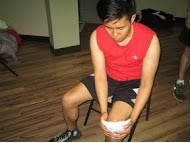Chrondromalacia patella is a condition where there is an overuse or injury and other factors on the cartilage that is found under the kneecap. It is also known as patellofemoral pain syndrome. The common symptom is pain in the knee when walking up and down the stairs. Simple treatments like rest and ice can help ease the pain caused by patellofemoral pain syndrome.
Symptoms of chondromalacia patella usually causes dull, aching pain that can be felt in front of the knee and the pain can be intensified during the following circumstances:
- Walking up and going down the stairs
- When kneeling or squatting
- Sitting with knees bent for long periods of time

Causes of patellofemoral pain syndrome
- Patellofemoral pain happens when the muscles found around the hip and knee does not function well in maintaining the proper tracking of the kneecap.
- Repetitive stress caused on the joints of the knee like running or jumping sports can result in patellofemoral pain.
- An injury to the kneecap like dislocation or fracture has been connected to patellofemoral pain syndrome.
Treatment and home remedies
- Rest the knee as much as possible and avoid doing activities that causes increase in pain such as climbing stairs.
- Take over-the-counter pain medications such as acetaminophen, ibuprofen and naproxen.
- Perform some rehabilitation exercises that can strengthen the muscles that functions in supporting the knees and controls alignment of the limbs such as the quadriceps, hamstrings and the muscles found around the hips especially the hip abductors.
- Provide knee braces or arch supports that can help protect the joints and improve kneecap alignment.
- Tape the knee to minimize pain and improve the ability to exercise. If you want to learn more about taping measures, click here.
- Apply ice compress on the knee after doing an exercise.
- During the recovery do some sports that do not cause too much stress on the knees like swimming and bicycling.
Prevention of patellofemoral pain syndrome
- Maintain strength by focusing on the quadriceps and hip abductor muscles in order to preserve the balance of the knees during an activity.
- Consult a physical therapist regarding the suitable flexibility and strength exercises in order to improve the techniques for jumping, running and pivoting. It is necessary to exercise the outer hip muscles in order to prevent the knee from caving inward when squatting, landing from a jump or stepping down from a step.
- If the person is overweight, lose some extra weight in order to relieve some stress on the knees.
- Perform warm up at least for five minutes with light activities before exercise.
- Stimulate flexibility by performing some mild stretching routines.
- Make sure the shoes used are not ill fitting and provide good shock absorption. If the person has flat feet, put some shoe inserts.
- Avoid making abrupt alterations on the amount of the exercises or the workouts.